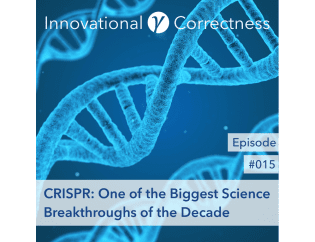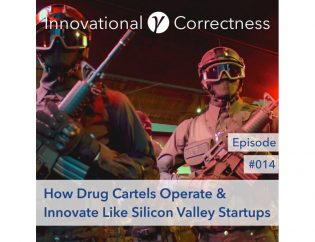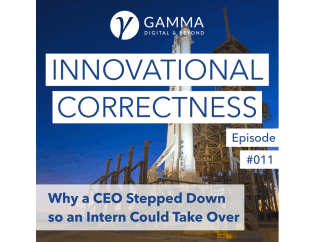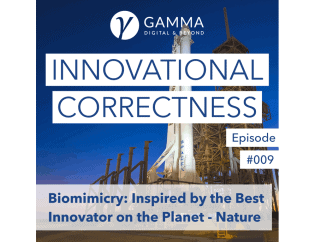This innovation & transformation podcast looks at innovators and companies that are changing the game and how they took their initial idea and created a game-changing product or service while giving you unique perspectives and insights you haven’t heard elsewhere. David and his guests discuss real-world practical advice on how to best harness the creativity of your employees and go from idea to product that has the potential to radically transform your business, all while separating hype from reality and replacing bullshit bingo with common sense.
Hosted on Acast. See acast.com/privacy for more information.
This episode explores a special material called gallium nitride (GaN) that is not only a super-efficient semiconductor but is also changing the tech industry and is destined to disrupt the established silicon industry. GaN tech could save 10% of the electricity consumption in the US alone. And consumers can already purchase products using this high-tech material. To further explore this fascinating material, I interview the multi-award-winning professor Martin Kuball.
This episode will explain:
- What gallium nitride (GaN) is
- The properties that make this material extraordinary
- What advantages GaN has compared to silicon
- How GaN is disrupting the silicon industry
- What challenges there are when developing GaN devices
- The common misconceptions people have about GaN and what aspects are over-hyped
- What it really takes to go from research to groundbreaking innovation and how much effort goes into producing next-generation technologies
- How our future could look like once GaN and next generations batteries are widely deployed
- What types of skills researchers need in order to go from research to product
- And finally, the biggest surprises and breakthroughs my guest has had during his career as a scientist
Show Notes, Transcription, & Resources Mentioned: gammabeyond.com/en/podcast/010
Podcast Website: www.innovationalcorrectness.com
—
If you enjoyed this episode, could I ask you for one small favor?
Would you please consider rating and reviewing this podcast on iTunes, Overcast, or the podcast app of your choice? It really helps us out, by encouraging more people to find our podcast and reach hard-to-get guests.
Last but not least, if you have any suggestions for further episodes or guests should be invited on this podcast or just have feedback, shoot us a quick email: or fill out our feedback form.
Follow & add David on:
LinkedIn:linkedin.com/in/davidluna/
Youtube: youtube.com/c/GAMMADigitalBeyond
Hosted on Acast. See acast.com/privacy for more information.
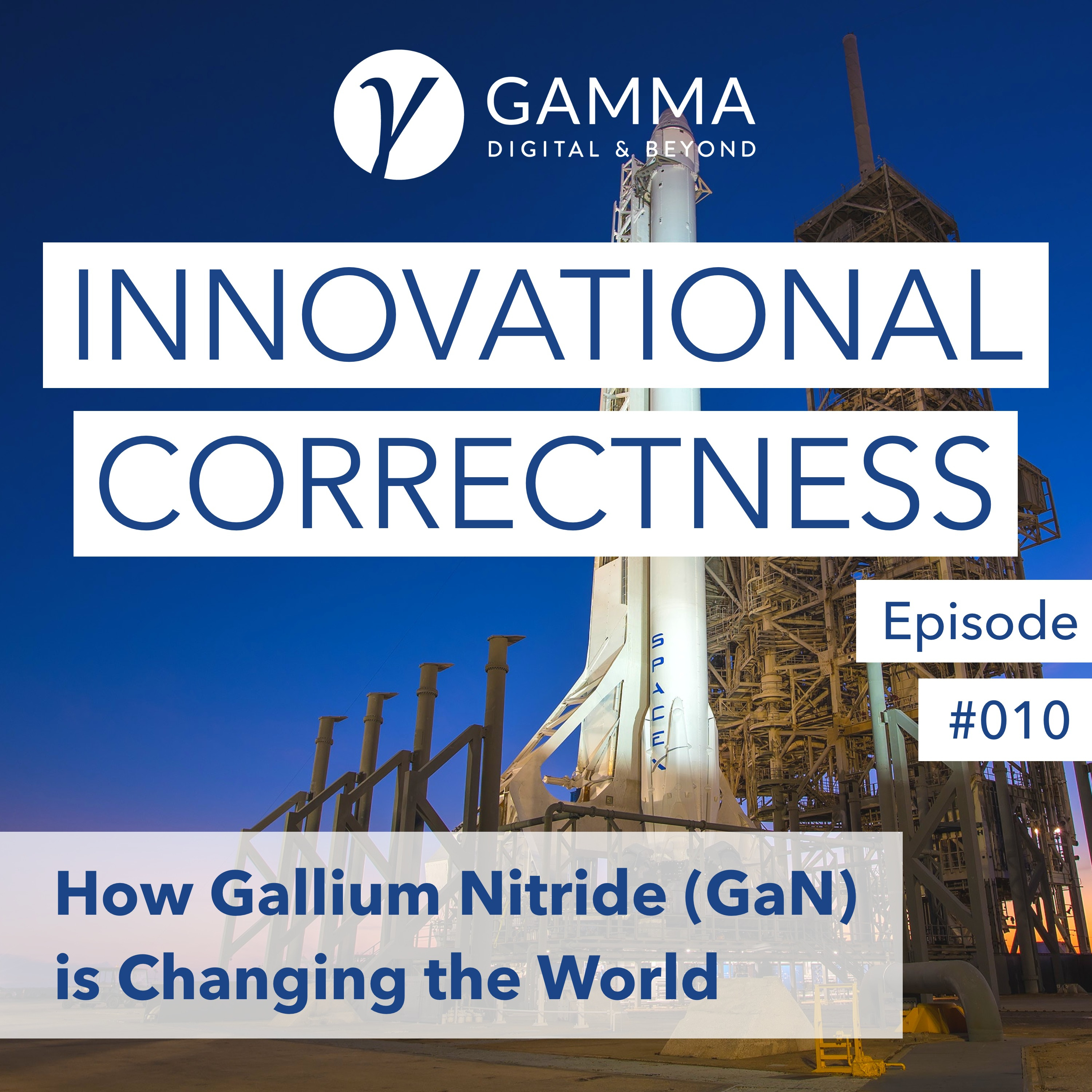
Show Notes
Episode Contents
This episode will explain:
- What gallium nitride (GaN) is
- The properties that make this material extraordinary
- What advantages GaN has compared to silicon
- How GaN is disrupting the silicon industry
- What challenges there are when developing GaN devices
- The common misconceptions people have about GaN and what aspects are over-hyped
- What it really takes to go from research to a groundbreaking innovation and how much effort goes into producing next generation technologies
- How our future could look like once GaN and next generations batteries are widely deployed
- What types of skills researches need in order to go from research to product
- And finally, the biggest surprises and breakthroughs my guest has had during his career as a scientist
Summary
- Gallium nitride (GaN) is a super efficient semiconductor.
- With GaN you lose only about 1% of the energy thay‘re trying to convert vs a silicon device, that loses about 3%. That might not sound like much, but as the vast majority of things include silicon, that‘s huge. Just for reference, you’d save 10% of electricity consumption in the US alone just by using GaN tech.
- GaN electronics is slightly more expensive than silicon. But if you built the whole system using GaN, it's actually much, much cheaper than using silicon in better performance.
- But the overall problem is systemic. Silicon is cheap. It's ubiquitous and companies trust the material. And there’s an entire electronics industry is built on it.
- The main obstacle for widespread adoption is essentially trust. Companies need to get used to this new material and technology. Companies also need to replace and optimize the whole electronics around and existing product. But companies tend to be very conservative. However, this adoption is slowly happening right now. But that takes some time.
- Some companies are trying to grow gallium nitride on top of silicon. The are using the platforms and equipment they already have, but even that still takes time. And so for now manufacturer will have to cope with multiple kinds of semiconductors.
- But it's important to remember, there are some applications where it's better to use silicon than GaN. And there's another material called Silicon Carbide that also has its benefits and drawbacks or gallium oxide. That leaves so much more room to explore.
- It will still take some time before gallium nitride takes over the world, but the market does seem to be growing.
Links & Resources Mentioned
Links Mentioned
- University of Bristol
- Wikipedia: Galium Nitrite
- ScienceDirect: Gallium Nitride
Articles Mentioned
- The Verge: Gallium nitride is the silicon of the future
Videos Mentioned
- YouTube: Is gallium nitride the silicon of the future? (interviewing Martin Kuball)
Studies Mentioned
- Recent publications of Professor Martin Kuball
Follow/Add the Podcast Host/Guest on:
David C. Luna: LinkedIn
Note: This transcript of the episode was machine-generated and has not been edited for correctness. It’s provided for your convenience when searching. Please excuse any errors.
[00:00:00] Host (David C. Luna): What were some of the most surprising things you've encountered with gallium nitride
[00:00:04] Guest (Prof. Martin Kuball): got him NATO to work, despite it having so many imperfections inside. And it's still, now has so many imperfections. If you take the same number of imperfections and trying to build a Silicon device like device with the same number of production, it would work.
[00:00:20] You could say gallium, nitride, device, physics, or device engineering. It doesn't. And that has baffled me. At the time when I was getting into that field, surprise me. I didn't think it's going to work either. And it still baffles me now.
[00:00:38] welcome to innovation. No correctness, a podcast, all about innovation and transformation hosted by David Luna, author keynote speaker and founder of gamma digital and beyond. David and his guests discuss real world practical advice on how to best harness the creativity of your employees and go from idea to product, giving you unique perspectives and [00:01:00] insights into their success all while separating, hype from reality and replacing bullshit.
[00:01:05] Bingo. With common sense, let's jump right into the show.
[00:01:11] Host (David C. Luna): Welcome to another episode of the innovational correctness podcast. What I'm currently holding my hand that you unfortunately can't see, because obviously a podcast is a small cube to be exact it's about 3.8 times 3.5 centimeters or 1.4 times 1.5 inches for you Americans out there, and it weighs about 60 grams and it's slightly smaller than a golf ball, and it puts out a whopping 30 Watts.
[00:01:38] Up to three amps without barely getting warm. And this will also be the topic of today's episode. actually it's the special, the material that's built into the supercharger and the material I'm referring to is called gallium, nitrite or GaN for short. Most of you have seen or experienced gallium in science class or seen videos on YouTube or [00:02:00] people put gallium on their hands.
[00:02:01] As it's melting point is around 30 degrees Celsius or 86 degrees Fahrenheit, where things get really interesting is when we combine it with the element, nitrogen is creates gallium, nitride, some materials like. Copper are really good at conducting electricity. Whereas materials such as glass are not as some of you might remember from school semiconductors are about halfway between those two extremes, which makes them really versatile for different products and use cases.
[00:02:30] What makes gallium nitrite so special is it's a super efficient, any conductor, how efficient, with GaN, you lose about 1% of the energy that you're trying to convert versus a Silicon device that only loses about 3%. That might not sound like much, but as the vast majority of have things include Silicon, that's huge.
[00:02:51] Just for reference, you'd save about 10% of electricity consumption. Just in the us alone by using gallium [00:03:00] nitride technology. What this means is that gallium nitric can replace many materials that are currently being used in the Silicon electronics industry today. Gallium nitride could also pave the way for a whole new generation of.
[00:03:13] Miniaturized and vastly more efficient tech in practical terms. This could also allow power to go straight from the outlet, into your laptop, for instance, and make them electrical cars or solar cells and much more efficient. And you need gallium, nitrite. Okay. Tronics to make this happen. My guest has been involved in gallium nitrite research for over 20 years.
[00:03:34] And during this time. Gallium nitride has already been used in quite a few applications, but semiconductors are where gallium nitride will really take off. My guest today is Martine Cooper. Martin is a multi award-winning professor and director of the center for device thermography and reliable building at the university of Bristol in the UK, his team about 20 international researchers and PhD.
[00:03:57] So students work with industry and academia [00:04:00] across the globe to develop. The next generation of technology for communication, microwave, better solar cells and more efficient power transmission. So in this episode, we'll explore or what gallium nitrite is in detail, the properties that makes this material so extraordinary.
[00:04:16] What advantages gallium nitride has compared to Silicon, how GaN is disrupting the Silicon industry. What challenges there are when developing again devices, what common misconceptions people have about this material in what aspects are, over-hype what it really takes to go from research to a ground breaking innovation, and how much effort goes into producing.
[00:04:38] Next generation knowledge is how our future could look like one day gallium, nitrate, and next generation batteries are widely deployed. What types of skills researchers need to have in order to go from research to product. And finally, the biggest surprises and breakthroughs my guest has had during his career as a scientist.
[00:04:57] All right, that's it. Let's go meet Martin.
[00:05:04] [00:05:00] Welcome to the podcast. Martin, do you want to tell the listeners who you are and what you're currently up to? My
[00:05:11] Guest (Prof. Martin Kuball): name is Martin Kewell. I'm professor at the university of Bristol in the United Kingdom and director of the center for device thermographic and reliability. And we work a lot on electronics on next generation electronics, which we think is exciting and opened a lot of opportunities for mobile phones, for power conversion to make our society, it would be hope better.
[00:05:32] Host (David C. Luna): So you also work with what's called gallium nitrite. So maybe you could explain to them, listeners who most are probably not professional chemical or physical engineers, what gallium nitric is, what its basic properties are and what makes it so special.
[00:05:48]Guest (Prof. Martin Kuball): yes, if you've worked on gallium nitride or work in an, a class of materials, which are called white bangup or older white van gaff materials, semiconductors, gallium, nitride, Gadi MOC site [00:06:00] diamond, just to tell a little bit about gallium, nitride, ACE.
[00:06:02]it's a material which contains 50% gallium and 50% nitrogen. It's a solid material. The atoms are arranged in a beautiful regular pattern and the material is that exist. Two different types of calcium, nighttime. One type of gallium nitride, the atoms are arranged in kind of a cubic fashion, but what is more common than we work on where the gallium notice is arranged in the head and the cool stuff with this material is that if you have electrons traveling through it, which you have in many electronic devices, they traveled very fast for this material, much faster than you.
[00:06:37] For example, have in Silicon.
[00:06:38] Host (David C. Luna): And why is that so crucial that electrons can move faster? faster always seems better, why is that relevant?
[00:06:46] Guest (Prof. Martin Kuball): So faster means what's the benefit. let's look at two different application of gallium noted in electronics. probably seen column noted actually used at home.
[00:06:55]it's used for light emitting diodes for white LEDs and lightening, but what we look at is [00:07:00] electronic applications. So I apply a voltage to this thing. if I have your mobile phone, That voltage is insight and the electrons going forth and back very quickly and the faster they go forth and back that easy are the places where it is.
[00:07:12] In many cases, you can communicate with someone else around the planet and somewhere in Europe, somewhere in Asia, and this makes it actually much more efficient. The communication. On the other hand, if I think about power conversions, So where you have, for example, your laptop plug in into an outlet, what you find, if these electrons move faster around the efficiency of actually charging your laptop is much better.
[00:07:37] The faster the electrons can travel, or if you have an electric vehicle, if you connected to a power outlet, the efficiency charging your car is much higher. That means it can be faster charged, but also you have less energy level.
[00:07:49] Host (David C. Luna): You mentioned some of the advantages that gallium nitride has. Another question I would have assumed.
[00:07:54] Most of the listeners is if it has such advantages, why hasn't everything moved from Silicon [00:08:00] to gallium nitride.
[00:08:01] Guest (Prof. Martin Kuball): It's been a long time around and Silicon is good and is being, having a youth. And if you look at develop a new material erotically, it's better than for example, Silicon, but it takes a long time to bring it to the level of where you can actually really compete with Silicon.
[00:08:16] Take an example. I have to make the material. I have to grow the material. Then I have to fabricate this material in something useful. Then I need to make sure that whatever comes out like an electronic device or power charger will last a long period of time. And this process takes 10, 20 years.
[00:08:32] And therefore only now you start seeing this gallium nitride really happening and appearing. And this is a reason why actually this is happening actually at that moment in time about Silicon spill is very useful just to make this clear you've compliments. What's what semiconductors can do. In Avis more, what semiconductors can do and it offers more opportunities.
[00:08:51] Like I can talk over long distance. I can charge something fast as I pointed out.
[00:08:56] Host (David C. Luna): Yeah. I personally experienced what gallium nitrite technology [00:09:00] can do in form of a charger. I have a charger from a well known, respected Chinese company and that. Little cube. And it's a really small can put out up to, I believe 35 Watts anywhere between one and a half amps up to three AM's and a generates very little heat.
[00:09:17] So it's quite astonishing what gallium nitride can do without developing much heat at all. So you mentioned an aspect that I would like to. Highlight and ask you a followup question. Growing such materials could take anywhere between 10 and 20 years. And I think consumers, we tend to be spoiled and underestimated the effort that goes into research or researching groundbreaking technologies because Hey, if we get an iPhone every single year, we expect that from every company and every groundbreaking innovation.
[00:09:48] And I think that's unfair as well. Maybe you could explain what it essentially takes to go from research to a commercial bleed. Viable product and how much time and effort goes into such product that then millions of [00:10:00] consumers can enjoy its benefits. For instance, my galleon nitrate charger. So maybe you could illustrate for the consumers out there.
[00:10:07] What it really takes to go from research to product.
[00:10:11] Guest (Prof. Martin Kuball): And if you look for example, in an iPhone or anything, basically you build your bike components and from across the planet, we design it. So this actually makes it, quick till you can just buy a component and a week later, get on my device and I can actually put it.
[00:10:28] We come together, but if I build effectively a new electronic component, take gallium, nitride as example, it's a beautiful example, right? Like nitride is not a perfect material. Do you find that makes it also exciting? if it takes Silicon, every atom sits where it's supposed to sit nature tends a little bit more difficult to make some atoms are the wrong location.
[00:10:48] That's initially fine, but the more you go to what's, the device is sometimes the wrong location of the atoms. Make the device not working so well, do you need to actually find the understanding what talk on [00:11:00] call to defects in the material, in these guiding nitrites and plenty of notes, it's acceptable.
[00:11:04] What does not acceptable? And if it's not acceptable, you have to find engineer these defects out. And this process just takes very long. It's much more complicated than me going to an ordering side of an electronics company and by a resistor or by capacitor or by an ancestor, the money being invested into actually developing these is a huge amount, the money.
[00:11:25] So this is just a bit more complicated, just the next generation of iPhone.
[00:11:29] Host (David C. Luna): Yeah, that makes me appreciate how much research goes into such groundbreaking technologies, such as gallium nitride. So from what I understood is you can't just take gallium nitrite as is, as it's available in nature, but you actually have to create a process that reduces its defects and alter its nature.
[00:11:48] So it can then be used for its intended application. Is that correct?
[00:11:52] Guest (Prof. Martin Kuball): That's correct. you have to alter defects and there will be always defects in the midterm, but some are benign don't matter. So this is [00:12:00] actually, there's a lot of physics it's going in there and there's a little chemistry going in there.
[00:12:03] A lot of engineering going in there and these three different disciplines, probably other ones actually have to work together.
[00:12:10] Host (David C. Luna): So could one generalize and say the higher, the voltage requirement is for certain application, the more suitable gallium nitride would be. Could one say that.
[00:12:23] Guest (Prof. Martin Kuball): Yeah, in principle, you can say, Silicon typically is more for the low voltage range in a simplistic term and the more power and more voltage, you have better.
[00:12:32] Some of these wide bang up technologies like gallium, nitride has come into play.
[00:12:36] Host (David C. Luna): If we recognize that gallium nitride has. A lot of advantages. Why not make the complete switch to gallium nitrite or asked her on the weight? How abundant or how scarce is gallium nitride as a material
[00:12:50] Guest (Prof. Martin Kuball): gallium, nitride is way more scarce than Silicon you'll find everywhere.
[00:12:53] But what you find in these gallium nitride devices, the gallium nitride layers in these devices are only a [00:13:00] few microns thin. So about a hundredth of a human, the diameter of a human hair. So the amount of material of the gallium, which is quite spares, nitrogen is not, it's fine because he don't actually need a lot of this material.
[00:13:13] Generally, compared to Silicon, you can apply a much higher voltages to know what devices they're looking at. Usually because the low voltage technology, not always, some tricks you can play with Silicon and because of this, you can actually build very efficient. iPhone is. It's you holding up there, a few volts voltages in there, but if yeah, car charger, it's going to be a hundred.
[00:13:35] It's a Volvo basically. And this is something, but you need some non Silicon technology. And here, if you look about the environmental benefits will be great. If each of us drives an electric car, it will be very good for environment, but you need a lot of power charges. And this is what this got in nighter technology.
[00:13:53] And that's alternative technology based on Silicon carbide can actually be delivered.
[00:13:58] Host (David C. Luna): So if we look back [00:14:00] to the 1990s and according to my research, gelling nitrate has already been used in LEDs back then, has there been a resurgence, all of a sudden of gallium nitrate, or why are we seeing galleon nitrate in other applicants, such as chargers, radars and et cetera?
[00:14:16]why is that the case? what changed.
[00:14:19]Guest (Prof. Martin Kuball): it's not really research and this has always affected regained going on there. LEDs are easy to make people started with the led and these electronic devices. The power switches, for example, are more difficult to make an led. they started also in 1993 or F roughly like this, but what you find in these power switches, because.
[00:14:41] Devices are smaller. The voltages are higher. They're high electric fields in the materials. So the materials degrade faster, if you don't do it. So it just took longer actually to develop the electronic materials and actually the electronic side off gallium nitride benefited a lot of the led on the led side, because there's so much investment [00:15:00] money flowing into gallium nitride, making how to make better material.
[00:15:04] And LEDs have resulted into resulting in making better gallium, nitride material. And with this, you see now the benefit of outside the led market, that's gotten 900 electronic devices coming in.
[00:15:15] Host (David C. Luna): Obviously no material is perfect. So what are some of the drawbacks that gallium nitride has? What are some of the environmental impact that gallium nitride has when compared to other materials?
[00:15:27]Guest (Prof. Martin Kuball): environmental drawbacks. you have people use different chemicals to the different material, so that plus or minus it's using Silicon and not Silicon, but what you typically find, which has a positive side on the environmental benefit. Firstly, obviously they're more efficient. You need less energy for a device, which has got him nitrogen in there.
[00:15:44] But also here's the devices or the secretary of build this calculator tend to be more simple than what you need to do with Silicon. So you actually need less components, but if there's an environmental impact, it will be more positive than negative.
[00:15:57] Host (David C. Luna): So at what point could [00:16:00] we see other applications that call beyond just chargers or for instance, when could we potentially see gallium nitride CPU as gallium nitride seems to be much better at thermal management or does that even make sense?
[00:16:14]Guest (Prof. Martin Kuball): the CPU market from my viewpoint will be dominant, continue to be dominated by Silicon, the alternative aspects around some people look up a few other techniques, but I personally don't see, got indicted to how, at least in the short time we have a major impact in the CPU market, because of Silicon is simply better in this field at that moment in time.
[00:16:35] So for digital open calls, electronic alumni tide is usually less suitable than Silicon.
[00:16:41] Host (David C. Luna): So I would assume as a consumer that if I can overclock or provide more voltage to the CPU, the more performance I get, but the less heat I have using gallium nitrite. So it would be better thermal management, but I assume there's much more involved in that.
[00:16:57] Is that the case?
[00:16:58] Guest (Prof. Martin Kuball): It's much more involved than that. [00:17:00] typically you like to actually stay at a lower voltage market or have it more efficient. And that's what Silicon has been trying to do. And. Just from the properties of the materials and called Silicon it's a narrowband gov materials, a very perfect material.
[00:17:12] Yeah. Use very little number of carriers in such CPU has got a nitrogen more defects in there. It's more tricky use for that particular area. then when, also aspects of , so there are certain key, but your properties where simply Silicon it's still better and would stay better because it's a narrow band gap.
[00:17:31] Host (David C. Luna): And how much effort generally speaking, would it be for a Silicon based manufacturer of say chargers to switch to gallium, nitride electronics. So switching the whole process from Silicon to gallium nitride,
[00:17:45] Guest (Prof. Martin Kuball): it's not difficult. you have to redesign the with around it, but from the production side, if you have a game night or certain component, you can just switch over.
[00:17:55] It's a lot of mentality or different thinking. This is obviously [00:18:00] slowing a little bit. The process over off the switch designers have to think different design us, North Silicon, very well. People feel comfortable with Silicon that it takes some time for them to adapt to different technology. People worry about the reliability.
[00:18:13] So how long a material. Device will operate. People are certain Silicon will operate for a long period of time. Kind of knighthood people may think are not sure I haven't worked with it yet. So it just needs a bit different thinking mud from the production facility, not a lot of changes needed.
[00:18:30] Host (David C. Luna): So how much pushback do you see in regards to gallium nitride from the very well established Silicon industry?
[00:18:36] Because I would assume if I am a very established industry, And have invested heavily into my processes, my factories, and so on. I'd want a proper return on investment. So I could assume that there is a lot of pushback as with, most new technologies. What's your take on that?
[00:18:56] Guest (Prof. Martin Kuball): That's actually a very interesting question.
[00:18:58] So obviously they [00:19:00] invested in it and obviously you want to have return. So that's natural with people trying to actually. Tim you have a Silicon, would you also have the existence of guardian knighthood actually pushed Silicon money factories to make better Silicon device by using new concept. So we've got a access and even pushed Silicon into making better device.
[00:19:19] What do you also see from the manufacturer side? there's something between cold to wait for the site. So if I make these electronic devices or devices in general, they start us. Round plates of material. Bye. You put, for example, a guy named nighttime down, or if you have Silicon, you just work with Silicon.
[00:19:38] You put that in processing machines and they make little devices on these waves as they get later on cutoff and just small little. So what you have and Silicon technology, people started as first as a way for size, maybe itself. That's nice. Four inch, six inch, eight, and 10 names and so on, making it bigger and Baker, which makes it secret.
[00:19:56] So the Silicon manufacturer is using actually quite large [00:20:00] pieces of Silicon, Melanie. This is an expensive process. You have to change the machines to make them accommodate bigger wafers, but what you also have for many of the manufacturers now, the old machines, which they used for the Silicon. Along a number of years ago, which don't have these large wafer sizes can actually accommodate the gallium nature.
[00:20:18] So what you actually find most Silicon companies, how are companies which make the devices also start making gallium nitride devices? Because they can use the old machines because they work with small way Fest sizes for the new technology. So there's a pushback to continue using Silicon, but there's also taking the benefit of, Hey, I have these old team.
[00:20:37] I can use them to make a new next generation
[00:20:39] Host (David C. Luna): device. That's very interesting because it sounds very much like low end disruption, low end corruption generally starts off with worse quality or worse performance than the incumbent. So in this case, Silicon, and it reminds me of the steel industry. So back in the us, The sixties, the mini mills, they use scrap [00:21:00] metal instead of producing steel with iron or so they only produced steel that was of low quality and thus, only produced rebar that was used in the construction industry.
[00:21:10] But over time or very quickly, they. Improved their performance and quality issues and moved up market. And so the incumbents as always, they always move up market because the lower markets are not of interest. Yeah. Mainstream customers tend to reject this new technology because again, it's worse off then what we have today.
[00:21:31] So it reminds me very much of low end disruption. Is that the case? Am I seeing this completely wrong?
[00:21:38]Guest (Prof. Martin Kuball): that's exactly how it is nicer. What's much worse off than other technologies and now is overtaking them. And when I went into that business off kind of nighttime many years ago, I was working in the U S at that moment in time, you were going to a meeting conference.
[00:21:53] Those people are presenting, whatever they looking at a different technology. These conferences were a 95% [00:22:00] Silicon gallium, Mars snowing. Indian phosphate technologies and maybe 5% of the people talked about counting 1900 people turning up into these sessions of gallium, nitride. And looking at this material is really bad.
[00:22:12] You will never be able to compete against myself. Like you said, it was at that moment time, really not good. And then you start making the material better and better, and you over text. So it's a good comparison to the dealer industry. It's the same game you start lower and then higher.
[00:22:27] Host (David C. Luna): Okay. So gallium nitride does seem to be on a very disruptive path.
[00:22:31] Then if going nitrate does have some of these great properties and gelling nitrate, transitions are generally faster and more efficient than say classical Silicon devices. What other challenges or limitations are keeping it from currently unseating the Silicon as on its, on his
[00:22:49] Guest (Prof. Martin Kuball): throne. in some sense, some areas is because Silicon from the mature properties will always be better than him.
[00:22:55] Nice. But then the low voltage market regime, gallium nitride would not be able to really [00:23:00] compete what you also have. Silicon is a proven technology, which is very reliable to devices last for a long period of time. Obviously gallium nitride is. We're still trying to establish itself to say, this is what we a lifetime and Colson more specifically mean meantime, pay a lifetime so that people say my device will last five years or 10 years.
[00:23:22] This is some of the challenges. What gallium nitride still needs to really demonstrate in. Some areas has very skim, demonstrated good reliability. It's either us is still needs to demonstrate also some aspects because gallium nitride isn't the perfect material. So there are some weeks and how you make these imperfections to have a lesson, other technology to improve the performance bedtime, but filling in this, just a proven technology, people, trusted designer, traffic and gallium, nitride people still have to prove an area.
[00:23:50] But apparently the chart says, for a home, different companies seem to be well accepted. I have the same experience. Would you party? I kind of project very quickly. It doesn't [00:24:00] get very hot. He'd start happening now.
[00:24:02] Host (David C. Luna): Now there are currently rumors and again, rumors, I couldn't back this up with any facts or any other evidence, but there are rumors that Apple will introduce a gallium nitrite.
[00:24:13] Charger. So if we take Apple as a mainstream producer of phones and charger and Oh yeah, dongles, then it seems that gallium nitrite is going mainstream at least slowly. Is that the case?
[00:24:26]Guest (Prof. Martin Kuball): I don't know what Apple is doing, but I would not be surprised. If they are thinking, doing something and he's offered to it's worth my peak keeping our minds.
[00:24:33] Okay. We're good. Talking here, is nice for power electronics, like for charges and things like that. But there's also, we talked about gallium nitride, finally, DS, which is well established for light white light bulbs. But there's a fact field as well, which I mentioned in between sometimes it's the bad she's got him nitride for mobile phone base.
[00:24:53] Stations for radars for some aspects like that. This is a market in between where gallium [00:25:00] nitride is less established than for light emitting diet, but much boy established then for power electronics or charge application, because at least a quarter, probably more of all mobile phone base stations right now use gallium nitride already.
[00:25:13] So gallium nitride is a different market penetration for different applications.
[00:25:18] Host (David C. Luna): So if we take gallium, nitride chargers can output much more power into say a tablet, a notebook phone, et cetera, lithium batteries. Don't like this higher output SIM for the simple fact that it produces a lot of heat and then degrades the battery.
[00:25:35] So the question now becomes are our devices ready for gallium nitrite for these superchargers? If you will.
[00:25:42]Guest (Prof. Martin Kuball): obviously if you have a new charge at technology, you want to look at new batteries. you can use gallium nitride devices with Karen batteries, obviously, as you correct. Is that their limitations?
[00:25:54] So you probably can use a full muscle power. I got in night to device could deliver to actually charge the [00:26:00] battery because it wouldn't like it. But then you, and there's a lot of research going on a new batteries research. they graphite batteries. We use graphing, which have some benefits. So if you develop new battery technology, then you can actually really take full advances.
[00:26:14] Host (David C. Luna): How far are we from a future like that? Where we really have true abundance of gallium nitrite. So from you as a researcher that puts it in a more. Realistic perspective of how far away are we from using much more gallium, nitrite devices of any kind? What's your estimate?
[00:26:34] Guest (Prof. Martin Kuball): Few years. it's ramping up now, so it's not going to be now.
[00:26:38] 1% of people use gallium nitride in tomorrow, a hundred percent use got a knighthood. So it's eight trend, which is increasing, but do you see that. Increasing over time in a few years, you have more galleon night to devices. If you may, off to that even more. I didn't know that.
[00:26:53]Host (David C. Luna): that sounds very promising.
[00:26:54] What are some misconceptions that people have about gallium nitride? That aren't really [00:27:00] true.
[00:27:00] Guest (Prof. Martin Kuball): That it's very expensive. If you go to catalog, for example, if you would be manufacturer of something, you look at the price of a Silicon device, or you look at the price of a gallium nitride device. So looking at as cheap and gallium nitride, more expensive, but what people sometimes are the misconception lies is if I build a circuit with Silicon devices, or if I use the gallium nitride device, the sacrad using it, I got him.
[00:27:24] Note her device is actually cheaper because you need less components. So there's a big mixed misconception and that site and some part of the technology sector,
[00:27:33] Host (David C. Luna): wouldn't a lack of scale. Also influence the price of gallium nitride.
[00:27:39] Guest (Prof. Martin Kuball): It's certainly to the scale of Silicon is a bigger way for us to, it's going to be cheaper.
[00:27:43] Also for gallium NATO devices. Typically these are gallium nitride on Silicon wafer devices. Silicon is an active part, but it's just a carrier. So it will always be more expensive than this Silicon device, because you start with Silicon, add something to it. Scale is one reason why [00:28:00] it's more expensive, but it's just a little bit more expensive to me in general.
[00:28:04] Host (David C. Luna): And what parts of this technology do you find completely overhyped and which parts do you think are.
[00:28:14] Guest (Prof. Martin Kuball): Probably over hyped in, but that's in any material sector is the statement. Gallium, nitride can do everything or any material can do everything, but that's not very realistic. Each material has served place in the food chain and night will be out performing in Silicon, some sectors, not in all sectors.
[00:28:33] We'll be outperforming what we'll call just Silicon carbide technology in some sectors, but not in all. Other sector. So that's something where it's a bit overhyped, what is forgotten. And actually what you're working on right now is that you can actually make materials better. Got him nitride by it, actually integrating with some other technologies.
[00:28:54] Like we work on gallium, nitride, integrated vis diamond, so that gallium nitride can deliver even [00:29:00] more power than a typical guiding nighttime device. By these two factor of three or a factor of six. So the opportunities, even for gallium, nitrite, and also opportunities for young researchers or young people to get involved into that research, it's not dead.
[00:29:15] A lot of it's not finished. It's a lot of opportunities coming up.
[00:29:19] Host (David C. Luna): Yeah, I think this is something that I in a lot of consumers tend to forget is when you have a material that's really good in certain areas. In certain applications, there are particularly bad or worse off in other contexts or applications.
[00:29:35] So there's always a trade off. In the special properties a material has in the first time I've heard of gallium nitride. I was like, Oh cool. This can do a lot of interesting things. Let's gallium, nitride, everything. But again, we tend to forget that there's always a trade off. How would a future with gallium nitride technology and.
[00:29:57] Graphene batteries look like. So if we could [00:30:00] combine both technologies and going beyond just car chargers, how would our future change? How would the future look like where we would have both technology? So having fast charging capabilities with little heat, but also the batteries that can take large amounts of power and charging without getting hot.
[00:30:20] How would something, or how would a future like that look like.
[00:30:24] Guest (Prof. Martin Kuball): You could think about electric planes, for example, you could think about obviously, always we talked about car charges, but just spending very little time to charge your car. I'd know her go to a gas station. It's very quick to fill my gas tank out, but for car charge, it will take me longer.
[00:30:39]I could think about my laptop, not having a power break at all, but just being straight, plugging into an outlet. I could have, with these graphing batteries, which have a good storage capability stays days and weeks, maybe just not charging things at all, a lot of opportunities,
[00:30:55] Host (David C. Luna): wouldn't it then become an arms race between the manufacturer of [00:31:00] devices, where they say, now that I have much more battery capacity and control much faster.
[00:31:05] No, I can build in these 15 CPS instead of just 10 wouldn't that then become just an arms race between the capabilities or capacities that I have and what I can do with those.
[00:31:18] Guest (Prof. Martin Kuball): Yes, the yes, certainly. this, there has been also lots of, history, not only from the arms race, but in technology, someone, make something more efficient than you can drive more power to get even more out.
[00:31:29]we've seen it in the laptops. if you go 10 years back, laptops did a job. No, they can do about 10 times more of them. But they use the same power. So it's a balance of what people want and how much environmental carbon footprint one to actually make. And people are probably nowadays much more aware of that.
[00:31:48] Humanity should be actually looking at the carbon footprint. I hope there's some sanity in the game.
[00:31:54] Host (David C. Luna): Yeah. Let's hope there is some responsibility left in us humans. So for companies [00:32:00] to continue to essentially delight consumers with products, they really love, and that provides benefits. There's always a need for higher performance at a low or cost.
[00:32:11] So in your view is galleon nitrate alone enough to satisfy this constant need for improvement? Or what else do we need for that to become reality?
[00:32:22] Guest (Prof. Martin Kuball): I've been going, first of all, I've got a note. It needs to be improved wider. Obviously it's only starting to commend to that will happen naturally with having its benefit.
[00:32:30] But then there's also important to realize there are materials already, now pipeline at a much lower cost technology ready level. Readiness level so much early in the development, which will add additional capabilities like as new material, which people get very hyped about right now, also using gallium, which is called calcium oxide or people thing that could also provide some benefits.
[00:32:53] This is more for even higher voltage applications than gallium. Nitride will make power transmission, or [00:33:00] even more efficient for our transmission lines. So there's. A lot of other material, civil often coming, which would compliment what Silicon can deliver. Cutting knighthood can deliver what Silicon carbide can deliver.
[00:33:13] And that makes it so exciting and fun to work in this field. It never stops there more opportunities to help humanity and make technology. And life's easier for people
[00:33:23] Host (David C. Luna): looking back 20 or 30 years. What were some of the most surprising things you've encountered with gallium, nitride, or even other materials?
[00:33:31] Guest (Prof. Martin Kuball): I brought it up a little bit earlier, already, which was that gallium, nitride of work, spite it, having so many imperfections inside and it's still now have so many imperfections. If you take the same number of imperfections and trying to build a Silicon device. device with the same number of in production, it would work.
[00:33:51] You could say gallium, nitride, device, physics, or device engineering. It doesn't, there are some reasons from the physics side, why is imperfections do not matter so much [00:34:00] for getting my time? And that has baffled me at the time when I was getting into that field. Surprised me. I didn't think it's going to work either.
[00:34:08] And it still baffles me now. And that's one of the exciting parts actually working in government
[00:34:14] Host (David C. Luna): life is full of surprises. So what would someone that is starting off in chemistry, physics, or any other STEM field that's interested in these kinds of topics and these types of technology? What type of skills are crucial?
[00:34:30] To go from research to product or to make research commercial bleak, liable, and put them into the hands of consumers. And when I'm referring to this, I always use the example of Russia back in the communist day versus the West where Russia was extremely good at research and invention, but really bad at innovation.
[00:34:51] So innovation is basically taking it intervention and making that commercially viable and making profits off of that. what are some of the [00:35:00] crucial skills I have to have in order to make an invention or research commercially viable? A
[00:35:06] Guest (Prof. Martin Kuball): certain openness in mind, talking to people across different countries in Russia, for example, was all with it, quite close society at that moment in time to go back.
[00:35:15] For example, in Russia, I'm good. Examples. Russia has always done amazing research and making, for example, diamond artificial diamonds. The time when Russia was closed, it will never was never going a commercial business. nowadays when Russia is open, now there's an increasing number of companies coming on from Russia who actually sell diamonds or are in the diamond market, but openness of a researcher to talk to people who use, for example, take the example of Kalymnos.
[00:35:41] They gave them a better product. What do you want, what do you need? Then go back in the lab and play around with the material, but keeping in mind where people could use it, that's probably a skill and that's not an easy skill of it. The ability to talk to. And to entrepreneurs to talk to people from other disciplines, [00:36:00] not in easy to skill, but very exciting.
[00:36:02] The ability to talk from people to other cultures is obviously now probably more open than 20, 30 years ago. All these are skillsets of attraction matter a lot, and actually making this transition university research, do some commercial application so equally and more incentives from government. To give people money to do that
[00:36:20] Host (David C. Luna): being user centric.
[00:36:22] And that's even very hard for established successful companies that always claim, we know what the customer wants instead of really taking, as you say, an open mind and asking what is the actual need behind what the customer wants. yeah, I definitely can get agree to that. That's a skill that every scientist should have on the other, the flip side, what are some of the most frustrating or.
[00:36:44] Counterproductive things that someone has to deal with when they're in this field.
[00:36:49]Guest (Prof. Martin Kuball): to follow on what I said already. One of them, the frustrating things I would see if you have commercialization advice, many companies think on a one or two year, if you develop the new technology, [00:37:00] like having nighttime to power converters takes 10, 20 years.
[00:37:03] So there's a tension between what a product and how much time has had to develop a product and how much actually it takes time to really develop the underlying component. So that can be frustrating. So you need to find the right people who have the openness to recognize some things, just take time and to have some patients that obviously what you also have in addition, what can be frustrations and not frustration.
[00:37:27] There are some technologies which are very hype and very. Driven, which takes some attention away from say poetic tonics politics, monies that would make our lives society extremely better. But from the outside, people think it's not exciting, but it is very exciting. And because other areas are a bit overweight.
[00:37:46] Host (David C. Luna): Yeah. I think that's just a general expectations we as consumers have, because we get phones every year, we expect every technology to. Move along equally as fast. And I can remember, obviously this was a very different [00:38:00] time in the late eighties. Maybe I saw I was watching television as a young boy and then heard something called abs active braking system.
[00:38:08] And they were testing it. I think it was Mercedes-Benz at that time or testing it in their trucks. And I remember how long it took for that to reach. The ordinary car that the so not luxury sedans. And I think there's just a very, we do research as a disservice by expecting these huge technological jumps within a few years or months or whatever, instead of, appreciating that groundbreaking innovations take time.
[00:38:34] They take time to research and often consumers don't know what, how long, research really takes. That's a point where maybe I can get your view on that as well as. Where Germany at least historically seemed to be extremely strong is laying the foundations of groundbreaking technologies. And the U S has traditionally, at least been very good at commercializing existing technologies.
[00:38:58] Is that still the case? [00:39:00] Is Germany still very strong in laying the foundation really strong in research or has that changed over the last decades?
[00:39:08]Guest (Prof. Martin Kuball): there have been certainly sex. I've seen the research culture in Germany because I studied in Germany originally. And I studied on a project which was funded by a German car manufacturer that was industry funding, which at that point was very unusual in Germany.
[00:39:25] So the building of industry funding, a nice illustration was in the corner of the campus, far away from everything else. Then I moved to the U S and study there and everything was very industry relations focused. That was working on the first Lou laser dice at that time as a collaboration between Brown university, where I work, which is on the East.
[00:39:43] Most of the main led manufacturers are laser dyed manufacturing. They could see actually the interaction between university and industry, much more being active in the U S and then I moved to England where it's also very active into industry university interaction, but I've seen off of Germany has moved.
[00:40:00] [00:39:59] Quite a bit, a long increasing university industry interact though. I think there's still room for improvement in Germany off and benefits to rebate.
[00:40:08] Host (David C. Luna): So this next question is probably going to be more over simplification or overgeneralization, but I'd still want to get your view on that, which is, I think it's.
[00:40:17] Every researcher's dream to have unlimited funding and have no restrictions placed upon the research, but getting funding for something like that is probably very difficult. So if you have commercial trusts involved, that kind of dictate what you can and cannot research, it's easy to get funding. But then on the other hand side, you have all these constraints, which might also dictate the results.
[00:40:40] So what's your opinion on that? That's
[00:40:43] Guest (Prof. Martin Kuball): a hard, it's a good question, but the, and a hard question to answer, because it's, as you say, quite generalized. So if you need a start from this end, I would say you need them. You need researchers who do fundamental research, irrespective of the applicant. So in the end, [00:41:00] people play around, they discover interesting things and they think maybe tooth, or maybe not, then you need researchers who are able to actually take these fundamental inventions to think about what they may be useful for.
[00:41:12] And then you need researchers who actually read it, implement these invention to read application. If you can't. For example, off the fundamental research has completely, you would lose the feed in of new ideas, into new technologies. In 20 years time, there's a balance across the food side. I personally started my career in doing surface signs, which had zero applications.
[00:41:33] I wasn't interested in application. At that point. And I found it an exciting work in the U S seeing, Oh, what I've done this actually very useful for light emitting diodes at that moment in time or now for electronic devices. So it's, you need parts of the food chain to actually when you work and each individual person can actually fit in.
[00:41:52] And I personally find it exciting to realize I studied a physicist. I'm probably doing more engineering now to realize what I'm actually [00:42:00] doing as for this is useful for something. And when I worked with the company, I always find it balanced so that there's going to be some benefits for the company, but equally I can generate ideas, which for the company may not be resulting in the benefits tomorrow, maybe in five years time.
[00:42:16] Host (David C. Luna): Yeah. I can definitely see that being very gratifying to see your research being applied and being used by consumers or even helping save lives, whatever that product is. If you look back in your career, what were some of the biggest breakthroughs you had as a researcher?
[00:42:34] Guest (Prof. Martin Kuball): Usually the brakes you're doing are coming from unplanned things are you play around?
[00:42:40] So for me, signs engineering is. You just, you play around experiment in different things for me work or not. so what have you done about many years ago with the falling? I was working with a technique called Raman spectroscopy. So what this technique is fundamental physics technique, you shine a laser on the material, the nasal atom, the laser [00:43:00] photons, other particles.
[00:43:01] Hit the material and they get scattered back. And some of it that it's the same wavelength as a laser, but some of it gets scattered back in a slightly different way, wavelength, which is related that you hit the atoms and the material and calls those phones. And this what you mentioned with the technique, Raman spectroscopy, and what we thought at that point was.
[00:43:18] Why not using this technique, not understand the materials to get him nature material, but trying to find, looking at a guardian Noto debate, what will be seen, but you didn't, you thought there could be some interesting stuff in there and won't be actually saw them if I've a device which off or switched it on something changes in what I record with a drum and spectroscopy.
[00:43:36] Missy, this would be invented to technique, which is called ramen. Thermographic where you can actually measure temperature in little tiny to ancestors. This high spatial means less than a micron spatial resolution, which no one could ever do before. And that's very relevant for when people want to figure out how long the device will actually live.
[00:43:55] And this was a very surprised at that moment in time. And no tried this before. And in [00:44:00] hindsight, it's actually very, once you discovered it, you could say, this is evidence. This is easy. Why did no one try this before? These are what I find out with the most things. When is most proud of simple ideas? Which then everybody else can understand and use and lots of people use the technique.
[00:44:15] Host (David C. Luna): Yeah. I think this comes back to my earlier comment about giving researchers more leverage or just the space to do research without any strings attached to it, give them a small fund or a small grant, and they can do whatever they like with it, similar to companies. And even for companies, it's hard to give employees the space to just try things out because most of the time.
[00:44:41] The more things you try, the more likely you are to find something surprising, or you're able to find a breakthrough, similar with post-its they were looking for 3m was looking for a new compound for a glue and it didn't stick very well. And then out came this successful failure, which is [00:45:00] post-its or Viagra.
[00:45:01] Or YouTube started off as a dating platform and then they failed miserably or they actually failed successfully if you will. I think we need to give not only employees, but also recent surgery is much more of a playground where they can try things out and be more in this. What a psychologist or some scientists have called the difference use mode.
[00:45:24] So you have the focus mode of your brain and then diffuse mode. Where you're not actively focusing on anything, but, have that brilliant idea in the shower cause rarely your best, the ideas come at the workplace or in the lab. So we need to give, I think researchers, employees much more leeway in trying and experimenting.
[00:45:44] Guest (Prof. Martin Kuball): I would agree with that fully. which mean our day society and funding works and the direction it gets more focused. So we didn't tell them and you can still do things like that. I agree one house needs out of the space to play around with because you find the unexpected. Okay. [00:46:00] The challenge to them actually recognize the unexpected.
[00:46:04] And then you're also willing to try things out, which you think will never succeed. Like when he tried to combine and got invited to diamond, I mentioned that earlier. I didn't expect it to work, but it's just worth trying out. And no, it's actually very useful technology for high power RF and power devices.
[00:46:22] So you need that space to. And funding to do this, obviously, to enable that needs to come back. In my opinion,
[00:46:30] Host (David C. Luna): I think this is something where companies need to learn from scientists. So when scientists have an idea, they go out and say, okay, what is the hypothesis? What hypothesis do we need to test?
[00:46:42] And either the right, are they wrong? They don't say, they failed similar to Edison. He said he didn't feel 500 times. He was just 500 times closer to the end result, which. Was the light bulb. So I think here, the companies need to learn that innovation is not linear. Innovation can really be [00:47:00] planned, but it can be done in a systematic way where I can start to test intelligent hypothesis.
[00:47:06] Even if I feel I learn, I learned something from the hypothesis, from the prototype that I have, and I think they're the companies need and can learn a lot from the scientific approach.
[00:47:20]Guest (Prof. Martin Kuball): I tell my PhD students, for example, often their post docs, you learn sometimes more by something not well.
[00:47:26] Host (David C. Luna): Yeah, absolutely.
[00:47:27] That's the right mindset to instill into a students or a future researchers to wrap this up. What are some of the most important things you would like the listeners to take away from this episode?
[00:47:40]Guest (Prof. Martin Kuball): first day, technology is fun and often important to reduce space. Your whole impacts of humans are in nature to make our lives better.
[00:47:48] That gallium nitride is actually a very exciting material, which will only increase in how much we use it. And with this, be safe, some energies that use our carbon footprint, but there's still many [00:48:00] opportunities to come and get him nature, but often other materials like gallium oxide, and that is also very important actually for.
[00:48:07] Or future developments, the young generation saying physics engineering through assigns. All these areas are actually really cool areas to go into. There are lots of job opportunities and creative opportunities in this. It'd be neat, those new young people to actually come in Europe and the U S Asia and help.
[00:48:27]obviously have fun and help society.
[00:48:29]Host (David C. Luna): if there's listeners out there that found this podcast episode really interesting and the topic and wanting to delve deeper into the research, or want to contact you, what's the best way to get a hold of you. Yeah,
[00:48:40] Guest (Prof. Martin Kuball): just drop me an email or my email address.
[00:48:42] Contact me via LinkedIn. If you want to connect via link, then we post a lot of updates. It would be doing research the same in Twitter. We do that. People see what happens.
[00:48:51] Host (David C. Luna): So is there something that I didn't touch on or forgot to ask you that I should have mentioned, or that you want to maybe add.
[00:48:58] Guest (Prof. Martin Kuball): The only thing, but I said before, [00:49:00] science and engineering is actually fun and it's actually, I feel sometimes under appreciate how much on it can be.
[00:49:05] Is it easy? No. And has the opportunity to meet people from all different cultures and that's very eyeopening. You learn a lot.
[00:49:16]Host (David C. Luna): those were perfect closing remarks. So thanks for all the fascinating insights into research and gallium, nitrite, and, yeah. Thanks for being on the podcast. Really.
[00:49:28] Guest (Prof. Martin Kuball): Thank you.
[00:49:28] Thanks for your time as well. I enjoyed it a lot.
[00:49:30] Host (David C. Luna): So we reached that segment again, where I try to summarize the interview and give you some of my thoughts. As we've seen with gelling nitrate technology, it's slightly more expensive than Silicon, not dramatically. but if we built the whole system using gelling nitrate technology, it's actually much cheaper than using Silicon, but with better performance.
[00:49:51] But the problem is actually systemic. Silicon is really cheap. It's ubiquitous and companies trust the material. And there's an entire electronics industry built [00:50:00] on the material right now, creating gallium. Nitride is expensive. You often have to use a lot of pressure or get very high too temperatures in order to grow Cali nitric crystals.
[00:50:10] And the growing process can not lead to a lot of defects. As Martin mentioned in this episode, which means you need even more. To get enough of the useful stuff, so to speak. So the main obstacle for widespread adoption is essentially trust companies need to get used to this new material and very disruptive technology.
[00:50:29] They need to replace and optimize the whole electronics around an existing product. And that can take some time, but they also tend to be very conservative. And however, this adoption is slowly happening. Right now, but also that will take some time. Some companies are trying to grow GaN on top of Silicon, as Martin also briefly mentioned, they are currently trying to use their platforms and equipment they already have, but even that also takes some time.
[00:50:57] And so for now, manufacturer will have to cope with [00:51:00] multiple kinds of semiconductors. But the important thing to remember here is. There are some application where it's better to use Silicon than gallium nitrate, and there's other materials called Silicon carbides that also has its benefits and drawbacks, or just as gallium oxide that leaves so much more room for scientists like Martin.
[00:51:20] To explore and see what they can come up with. It will still take some time for going nitrate to take over the world, but the market does seem to be growing and I'm really excited to see what's in store for the future. And if you want to experience galleon nitrate for yourself, go out and buy a Kalyn nitric treasure from a reputable manufacturer and, be astonished of what that little thing can do.
Have feedback or recommendations for topics or guests?
Let us know, by filling out this short form here.

This podcast looks at innovators and companies that are changing the game and how they took their initial idea and created a game-changing product or service, while giving you unique perspectives and insights you’ve probably haven’t heard elsewhere.
David and his guests discuss real-world practical advice on how to best harness the creativity of your employees and go from idea to product or service that has the potential to radically transform your business.
They also share lessons they’ve learned along the way to effectively accelerate, incubate and scale innovations within small, medium and large enterprises, all while separating hype from reality and replacing bullshit bingo with common sense.
The show is hosted by David C. Luna, author, keynote speaker and founder of GAMMA Digital & Beyond.
The Innovational Correctness Podcast by GAMMA Digital & Beyond, David C. Luna is licensed under a Creative Commons Attribution-NonCommercial-ShareAlike 4.0 International License. Based on a work at gammabeyond.com/en/podcast/. Permissions beyond the scope of this license may be available by contacting us here.





